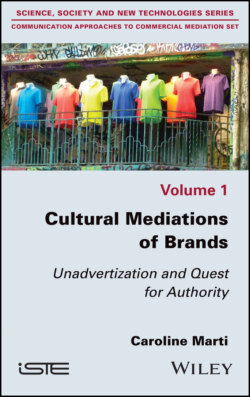Читать книгу Cultural Mediations of Brands - Caroline Marti - Страница 13
I.2.3. The disgrace of commercial communication
ОглавлениеThis perceived impurity raises questions. In countries other than France, particularly English-speaking countries and Japan, it is not so significant, as the mass culture of which brand emanations are a part of has the reputation of being perceived in a more favorable and homogeneous way. In France, this continuum seems unevenly acceptable. It is undeniably linked to the representations that innervate our personal and collective encyclopedias. The view that we can take of hybridization phenomena only makes sense in terms of the production of categorizations. The categories to which we refer are thus structuring our vision of the world. As paradigms and patterns evolve, my way of observing may appear obsolete in some time, several years or decades, since our representations transform our opposition systems as practices evolve9.
The cultural figurations of brands that I will present are the result of a search for value and the intense and broad form of what Barthes (1991) described when he evoked advertising, the commercial motivation being “doubled by a much broader representation, since it makes the reader communicate with the major human themes” (author’s translation).
Like Greimas (1986) who made Judas an adjunct to the Gospel narrative, social disgrace is, in my view, an essential adjunct to commercial speech, condemned to regenerate itself by assimilating and recycling the criticism made of it.
This feature of advertising rhetoric has been observed by linguists and ICS researchers, including Adam, Berthelot-Guiet, Bonhomme and Lugrin. The degraded social reception of advertising, coupled with a certain vulgarity and invasive power, has led to changes in brand communication. In the collective book on unadvertization (Patrin-Leclère et al. 2014), this fundamental question of social criticism is addressed, and I recall it here, because it is necessary for the continuation of the subject and the understanding of the mechanisms at work in cultural figurations.
Commercial communication has been the subject of considerable suspicion for a very long time, whether it is emblematic advertising or the most spontaneous vernacular form: salespeople’s discourse. The scope of explanation varies according to whether the primacy of this mistrust is attributed to the rhetoric inherent in these messages, in which case Plato’s Gorgias constitutes a solid starting point with the criticism of sophists, ready to convince without their words being at the service of truth, or if trade itself, a vulgar and material activity opposed to the nobility of the spiritual, is favored as a starting point for mistrust, as denounced in particular in the biblical account of the famous parable of the merchants driven out of the temple.
In both cases, market rhetoric is opposed to fundamental values of societies – the truth and the sacred. This constitutive antinomy of representations of commercial communication has been found over the centuries and has been mentioned in many discourses: literature, media, songs, etc. (Martin 1992). Criticism has grown richer, it is multifaceted, coming from thinkers and researchers, especially those working on communication and mass culture, and also especially from “anti-marketing” political staff, or staff of associations. Criticism, originally philosophical and religious, has thus become political, sociological, and environmental over time. It crystallizes both the denunciation of a social and political system based on liberal ideology and consumer society and the denunciation of rhetoric that seeks to stigmatize and invade10. The most critical are those who lend it the most power, as a corollary to a perception of a target of potential passive and fragile consumers, easily destabilized and convinced by these discourses.
These criticisms have largely penetrated people’s minds and circulated in social spaces. They have come together with the development of skepticism among professionals, publicists, advertisers, and media specialists. Many actors were thus moved by an advertising that would no longer be sufficiently appreciated to be effective, by a saturation of the media that would lead to the wear and tear of the genre. Some have gone further by referring to a change in consumers to such an extent that it could be called a paradigm shift.
It is true that paradigmatic upheavals are often mentioned by various thinkers or researchers, the rupture being the opportunity for those who announce it to proclaim a new order and to establish themselves as a guide to the terra incognita that is open to discovery. It is generally stimulated by technological innovation and accompanied by escort speeches11 from economic and social actors. The 1990s had thus seen a “new paradigm” in the field of marketing with the emergence of “relationship marketing”. It valued both the technical possibilities offered by the evolution of information technology, with the famous so-called relationship databases that were linked together, and a rather new perception of the consumer identified as an individual to be captured in a “holistic” way, likely to be loyalized and considered as a target in their own right, hence the appearance in these years of the no less famous and paradoxical one to one.
